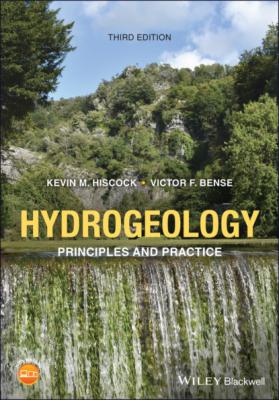ТОП просматриваемых книг сайта:
Hydrogeology. Kevin M. Hiscock
Читать онлайн.Название Hydrogeology
Год выпуска 0
isbn 9781119569510
Автор произведения Kevin M. Hiscock
Жанр Биология
Издательство John Wiley & Sons Limited
As with the first edition, the main emphasis of this second edition is to present the principles and practice of hydrogeology, without which the appropriate investigation, development and protection of groundwater resources is not feasible. An important addition to the current edition is Chapter 3 in which regional characteristics such as topography, compaction and variable fluid density are introduced and explained in terms of geological processes affecting the past, present and future groundwater flow regimes. In support of the new material presented in this chapter and throughout this second edition, and given the positive reception to the case studies published in the first edition, a further 13 boxes are included, as well as a set of colour plates, that are drawn from our teaching and research experience. The case studies illustrate international examples ranging from transboundary aquifers and submarine groundwater discharge to the over‐pressuring of groundwater in sedimentary basins and, as a special topic, the question of whether there is groundwater on the planet Mars. To help with a more rational presentation, some reorganization of material has occurred to separate investigation of catchment processes required to understand the role of groundwater as part of a catchment water balance (Chapter 6) from groundwater investigation techniques used to determine aquifer properties (Chapter 7). Also, Appendix 10 now includes a set of answers to the review questions in order to assist the reader consolidate his or her hydrogeological knowledge and understanding.
Kevin Hiscock & Victor Bense, Norwich
July 2013
Preface to the first edition
In embarking on writing this book on the principles and practice of hydrogeology, I have purposely aimed to reflect the development of hydrogeology as a science and its relevance to the environment. As a science, hydrogeology requires an interdisciplinary approach with applications to water resources investigations, pollution studies and environmental management. The skills of hydrogeologists are required as much by scientists and engineers as by planners and decision‐makers. Within the current era of integrated river basin management, the chance to combine hydrogeology with wider catchment or watershed issues, including the challenge of adapting to climate change, has never been greater. Hence, to equip students to meet these and future challenges, the purpose of this book is to demonstrate the principles of hydrogeology and illustrate the importance of groundwater as a finite and vulnerable resource. By including fundamental material in physical, chemical, environmental isotope and contaminant hydrogeology together with practical techniques of groundwater investigation, development and protection, the content of this book should appeal to students and practising professionals in hydrogeology and environmental management. Much of the material contained here is informed by my own research interests in hydrogeology and also from teaching undergraduate and postgraduate courses in hydrology and hydrogeology within the context of environmental sciences. This experience is reflected in the choice of case studies, both European and international, used to illustrate the many aspects of hydrogeology and its connection with the natural and human environments.
Kevin Hiscock, Norwich
May 2004
Acknowledgements
No book is produced without the assistance of others, and we are no exception in recognizing the input of colleagues, family and friends. Several people have provided help with proof reading sections and in supplying references and additional material. These people are Julian Andrews, Alison Bateman, Ros Boar, Lewis Clark, Sarah Cornell, Kate Dennis, Alan Dutton, Jerry Fairley, Aidan Foley, Tom Gleeson, Thomas Grischek, Rien Habermehl, Norm Henderson, Mike Leeder, Beth Moon, Lorraine Rajasooriyar, Peter Ravenscroft, Mike Rivett, Raphael Schneeberger, Wilhelm Struckmeier and John Tellam. An enormous thank you is owed to Phillip Judge, Sheila Davies and Laura Hiscock for their patient and expert preparation of the majority of the figures and Rosie Cullington for typing the many tables contained throughout. The staff, facilities and electronic resources of the Library at the University of East Anglia are appreciated for providing the necessary literature with which to compile this book. If this were not enough, we are indebted to Tim Atkinson, Richard Hey, Alan Kendall and Helen He for helping form the content of this book through the years spent together teaching and examining undergraduate and postgraduate students in hydrology and hydrogeology in the School of Environmental Sciences at the University of East Anglia. We are also grateful to the editorial team at John Wiley & Sons Limited for their guidance and support during the publication process. Last but not least, we again especially thank Cathy, Laura, Rebecca, Sylvia, Ronja, Kailash and Nico in supporting our endeavours in hydrogeology and for their patience during the time spent preparing this new edition.
Symbols and abbreviations
Multiples and submultiples
| Symbol | Name | Equivalent |
|---|---|---|
| E | exa | 1018 |
| P | peta | 1015 |
| T | tera | 1012 |
| G | giga | 109 |
| M | mega | 106 |
| k | kilo | 103 |
| h | hecto | 102 |
| da | deca | 101 |
| d | deci | 10−1 |
| c | centi | 10−2 |
| m | milli | 10−3 |
| μ | micro | 10−6 |
| n | nano | 10−9 |
| p | pico | 10−12 |
Symbols and abbreviations
| Symbol | Description |
|
|---|

